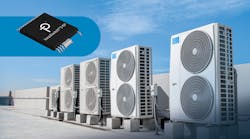GaN Flyback-Switcher IC Hits on Higher Voltages
Check out more of our APEC 2023 coverage.
A just-released 900-V GaN flyback-switcher IC is built with the reliability and ruggedness to handle harsh conditions in everything from industrial motors to electric vehicles, according to developer Power Integrations.
The new offering, called the InnoSwitch3-EP, is based on the company’s unique PowiGaN technology and belongs to its InnoSwitch3 family. The chip can supply up to 100 W (at 230 V ac ±15%) with better than 93% efficiency, removing the need for heatsinks and other bulky cooling systems in power supplies that already have limited space.
Rated for up to 900 V, the InnoSwitch3-EP can easily accommodate inductive noise spikes, yet also operate from as low as 30 V dc, enabling systems to meet functional-safety active discharge requirements.
Power Integrations said the fast switching and high efficiency of gallium nitride (GaN) relative to silicon MOSFETs and IGBTs suits the 900-V GaN part for three-phase industrial motors and auxiliary power supply units (PSUs) in servers.
GaN is upending the market for power electronics as it facilitates higher power density at a given voltage and current rating than standard silicon MOSFETs and IGBTs. But GaN tends to lose out to these and other chips, including SiC MOSFETs, at voltages levels above 650 V. One of the major features of GaN is its high frequency switching, which results in more compact form factors and helps slash costs at the system level.
Automotive-Grade
Power Integrations also rolled out a 900-V automotive-grade variant called the InnoSwitch3-AQ. It’s suited for 400-V bus systems in electric vehicles (EVs) where the 900-V rating of the device provides more power and increased margin―required for 12-V battery-replacement systems―with enhanced efficiency over silicon.
Today, most cars on the road have power-distribution systems that can manage the moderate amounts of power pumped out of 12- and 48-V battery packs. But as the EV era takes shape, 400- and 800-V batteries—and bus voltages to match—are becoming the industry standard. As a result, the modern EV is evolving into a complex, high-voltage power-delivery system that resets the bar for safety and efficiency.
Doubling the operating voltage equates to a roughly 50% reduction in current, thus cutting the current flowing through the EV's wiring. Losses due to resistance heating also are limited. On top of reducing the weight and cost of the EV, the use of high voltages helps speed up battery charging. While silicon IGBTs can hit these high voltages, they’re subject to higher losses that make switching efficiently at high speeds more of a challenge.
As the bus voltage in electric vehicles rises to 400 and 800 V, companies are reengineering various power stages under the hood, including the on-board chargers and dc-dc converter units, said Power Integrations.
GaN power ICs keep switching loss in check, which helps limit power dissipation. Higher efficiency reduces power losses when converting or distributing power in the EV, which allows for the removal of bulky heatsinks and, in turn, lowers the overall volume, weight, and cost of the onboard charger or other EV system. These features free up space and weight that can be allocated to other areas of the design.
Even though they're aimed at 400-V bus voltages, the AEC-Q100 Innoswitch3 chips are said to bring a level of performance and protection similar to those of its 1700-V SiC FETs that target 800-V subsystems in high-end EVs.
Bus Voltage Boost
The offline CC/CV flyback-switcher ICs employ synchronous rectification, a valley-switching discontinuous-conduction mode (DCM), and continuous-conduction mode (CCM) flyback controller.
The ICs are pin-for-pin compatible with existing 725- and 750-V offerings, giving its customers additional margin for managing voltage transients, specifically with unstable line voltages. The light-load efficiency of the Innoswitch3-AQ excels when it comes to supplying auxiliary power to EVs during low-power sleep modes.
The company’s FluxLink communication technology enables the IC package to bridge the isolation barrier without optocouplers, optimizing efficiency and the system’s bill of materials (BOM).
With standard and peak power-delivery options, the devices add protections against line overvoltage and undervoltage, output overvoltage, and overcurrent limiting. Overtemperature shutdown also is supported.
Pricing for the InnoSwitch3-EQ starts at $2.00 each in 10,000-unit quantities.
Check out more of our APEC 2023 coverage.

